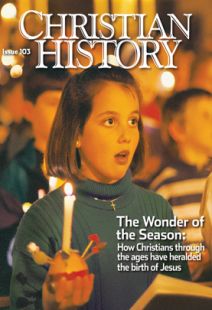Mary, the Sinless?
A NUMBER OF VENERABLE BELIEFS about Mary originate in a little-known book. Even those who know little about the veneration of Mary in church history have probably encountered a number of beliefs about her that can’t be found in the Gospel accounts: the names of her parents, for example, or her supposed “immaculate conception” (birth without sin). Many of these come from a single source: the “Protevangelium” or “Gospel of James.”
Although rejected as uncanonical in the sixth century, this book provided the material for many of the most important medieval legends, artistic representations, and ultimately theological beliefs about Mary. A Jewish-Christian work of the second century, it is an infancy narrative with extensive elaborations attesting to the sanctity and special powers of Mary.
A very Old Testament birth
The Gospel of James tells the story of how Mary’s parents, Joachim and Anne, childless in their old age, were blessed by the birth of this special child. If the story has a familiar ring, it is because it closely parallels the biblical account of Isaac.
The Protevangelium also portrays Joseph as an old man, a widower with grown children, at the time of Mary’s espousal to him. Recognizing, her extraordinary purity and set-apartness, Joseph becomes more of a caretaker than a husband to Mary.
A number of early church fathers, including John of Damascus and Sophronicus, cited or commented on this account of Mary’s conception, birth, and life, and it evolved during the Middle Ages into various other Lives of Anne. Other apocryphal Gospels contributed material, including the “Mary” Gospel of Pseudo Matthew. These narratives focus on Anne’s childlessness through 20 years, at which point Joachim became a recluse out of shame. The couple’s prayers were eventually answered: an angel appeared to each individually, promising a child who will become known to the whole world. Joachim and Anne were reunited at the Golden Gate (the subject of a painting by Dürer), and eventually the child, Mary, was born.
In the Protevangelium, the story resembles that in I Samuel 1 concerning the barren Hannah, whose prayer for fruitfulness is likewise answered (“Hannah” and “Anna” or “Anne” are variants of one name), and Mary is similarly sent up to the temple to be raised as a virgin (an historical improbability), there to help weave a new veil with “true purple,” the royal color.
Pure from the first
The Protevangelium also contributed to the belief in Mary’s “immaculate conception”: from the first moment of her conception, she was preserved from the stain of original sin. The Protevangelium draws a parallel between Mary’s conception and that of John the Baptist, sanctified in Elisabeth’s womb (Luke 1:15), seeming to suggest that the conjugal begetting of Mary was somehow devoid of sinful taint.
While some more elaborate justifications for a “sinless Mary” have been offered, especially in the later Middle Ages, this is still essentially the position of the modern Catholic church: “Sanctifying grace was given to her before [original] sin could have taken effect in her soul.”
This view, though often challenged, has had notable champions. In refuting Pelagius, Augustine is among those who declares that while all those justified by grace have known sin, he cannot, “for the honor of the Lord.” even question whether Mary might have sinned (Nature and Grace, 100.36).
The term “Immaculate Conception,” relating strictly to Mary's own conception, appeared in the formal liturgy first in 1854 (Pius IX), though the feast was adopted for the entire Latin church in 1476 (by Sixtus IV). CH
By David Lyle Jeffrey
[Christian History originally published this article in Christian History Issue #103 in 2012]
David Lyle Jeffrey is Distinguished Professor of Literature and the Humanities and Provost of Baylor University.Next articles
Advent: Close Encounters of a Liturgical Kind
'Tis the season when even the free-ranging revivalist pulls up a chair to the table of historic liturgy
Chris ArmstrongSupport us
Christian History Institute (CHI) is a non-profit Pennsylvania corporation founded in 1982. Your donations support the continuation of this ministry
Donate



